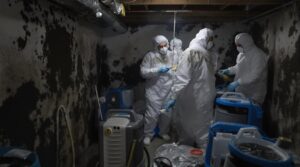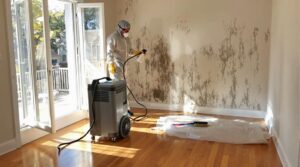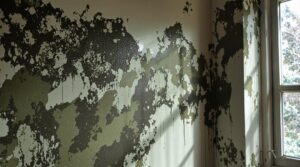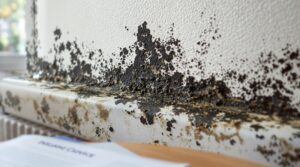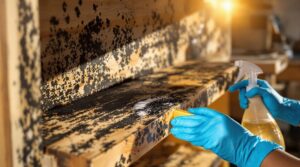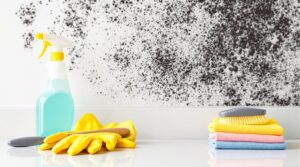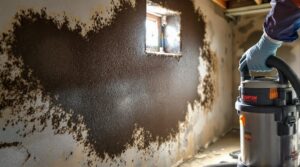Removing bathroom ceiling mold requires proper safety equipment, including an N-95 respirator mask and eye protection. A solution of white vinegar or 1:10 bleach-water mixture should be applied to affected areas for 10-15 minutes before scrubbing with a soft-bristled brush. Proper ventilation must be maintained during the process using a box fan positioned outward. After treatment, installing humidity-sensing ventilation and maintaining 30-50% moisture levels prevents future growth. Understanding additional prevention strategies guarantees long-term success.
Key Takeaways
- Install a properly sized exhaust fan and run it during showers plus 30 minutes after to reduce moisture buildup.
- Apply white vinegar or 1:10 bleach solution to affected areas for 10-15 minutes, then scrub with firm circular motions.
- Use protective gear including N-95 mask, gloves, and goggles when cleaning mold to prevent exposure to spores.
- Position a box fan in the window pointing outward to improve ventilation while cleaning the ceiling.
- Maintain bathroom humidity between 30-50% using dehumidifiers and proper ventilation to prevent mold regrowth.
Understanding Bathroom Ceiling Mold
Bathroom ceiling mold frequently develops due to the perfect storm of conditions present in most bathrooms: high humidity, warm temperatures, and limited ventilation. The moisture science behind this phenomenon involves water vapor from showers, baths, and sinks rising and condensing on cooler ceiling surfaces, creating an ideal environment for mold formation. Physical weakness and fatigue can occur in occupants exposed to bathroom mold due to damaged mitochondrial function.
Two common types of growth can occur: black mold, which thrives in high-moisture environments and appears as dark patches, and mildew, which manifests as lighter-colored spots in areas with moderate humidity.
The presence of plumbing leaks, insufficient natural light, or compromised roof integrity can accelerate mold development. Among the most dangerous types of mold, Stachybotrys can appear as slimy black or green patches and poses severe health risks. Understanding the specific type of mold present is essential, as different varieties require distinct treatment approaches.
The combination of trapped moisture and warm temperatures creates a sustained breeding ground for spores, particularly in bathrooms where ventilation is inadequate or improperly maintained.
Essential Safety Precautions
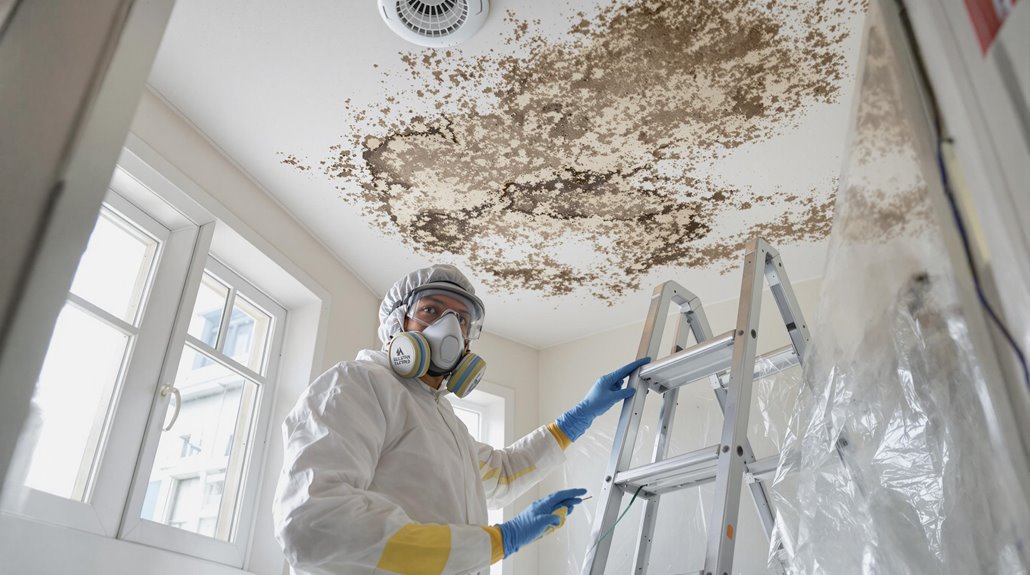
Before attempting to remove bathroom ceiling mold, individuals must equip themselves with protective gear including gloves, goggles, a respirator mask, and appropriate clothing to prevent exposure to harmful spores.
The work area requires proper ventilation through open windows and exhaust fans, while simultaneously containing the space by closing doors and shutting off HVAC systems to prevent spore dispersal. Immediate action is crucial since mold colonies emerge within just 48 hours to one week after moisture exposure.
Creating a secure work zone involves laying down protective sheeting, ensuring stable ladder placement, and maintaining adequate lighting for clear visibility of the affected areas. Experts recommend letting the area ventilate for 15-minutes before beginning any cleaning work.
Wear Proper Safety Equipment
Safety equipment is essential when tackling bathroom ceiling mold removal to protect against harmful spores and cleaning chemicals. The minimum protective precautions include wearing an N-95 respirator mask, safety goggles, and rubber or nitrile gloves with long cuffs. Long-sleeved clothing, pants, and waterproof boots or closed-toe shoes provide necessary skin protection. Poor ventilation conditions can intensify exposure risks when removing mold from bathroom ceilings.
Proper gear maintenance is vital for effectiveness. After completing mold removal tasks, either dispose of or thoroughly clean all protective equipment to prevent cross-contamination and mold spore spread. Children living in homes with inadequate protection during mold removal face triple asthma risk by age seven.
The N-95 respirator must have appropriate mold-rated filters, and all safety gear should fit correctly to guarantee maximum protection. These measures safeguard against potential health risks, including respiratory infections, allergic reactions, and exposure to harsh cleaning solutions.
Ventilate Your Work Area
Proper ventilation represents a critical safety measure when removing bathroom ceiling mold to prevent the spread of airborne spores throughout living spaces. A HEPA-filtered fan unit should be positioned to maintain negative pressure in the work area, ensuring proper airflow away from occupied areas and toward outdoor exhaust points.
Before beginning mold removal, seal off the bathroom by taping plastic sheeting around doorways and installing a box fan in the window pointing outward for directional ventilation. This containment strategy minimizes spore dispersal into other rooms.
The ventilation system should operate continuously during the removal process and for at least 24 hours afterward. In humid conditions, incorporate a dehumidifier to maintain ideal moisture levels between 30-50%, as monitored by a hygrometer.
For areas larger than 100 square feet, implement a double-layer containment system using 6-mil fire-retardant polyethylene sheeting to ensure maximum protection.
Secure The Work Zone
With ventilation established, securing the work zone requires thorough containment protocols to minimize exposure risks during mold remediation. Installing work barriers using plastic sheeting and sealing off doorways prevents spores from contaminating adjacent areas. Access control measures guarantee only properly equipped personnel enter the containment zone.
Before commencing work, all valuable items should be removed from the affected area to prevent damage. Drop cloths and plastic sheets must be strategically placed to contain falling debris and spores.
The implementation of proper personal protective equipment is essential, including respirators, gloves, eye protection, and full-body coveralls. Tools and cleaning materials should be designated specifically for the contaminated area to prevent cross-contamination. Following these containment protocols creates a controlled environment that protects both workers and unaffected spaces during the remediation process.
Using double-layered polyethylene barriers for containment is crucial as mold counts can increase up to 1,000 times during the removal process.
Required Tools and Materials
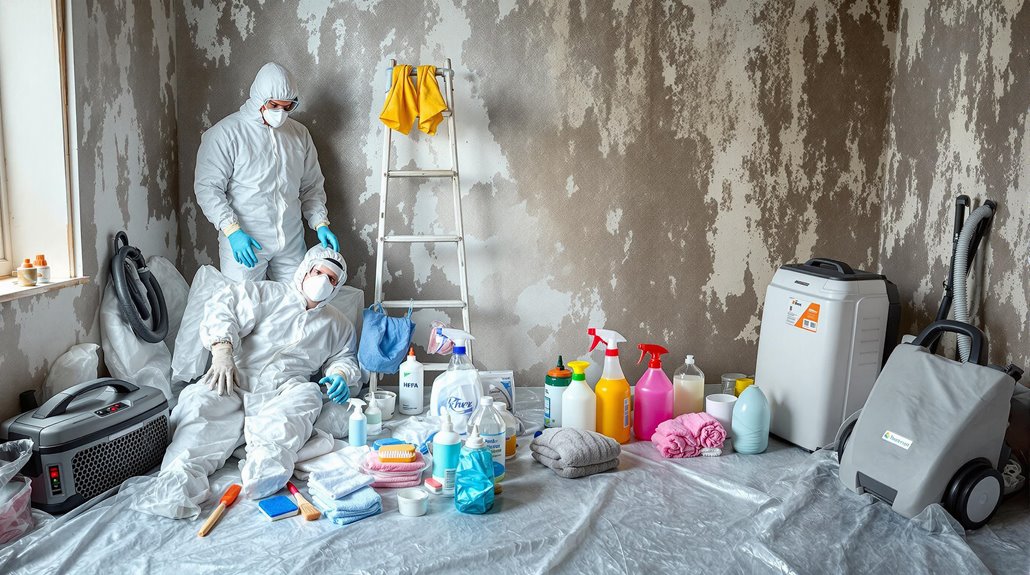
Tackling bathroom ceiling mold requires a thorough set of tools and protective equipment to guarantee both effective removal and worker safety.
Proper tool organization begins with assembling essential protective gear: rubber or nitrile gloves, respiratory protection such as Draeger masks or 3M PAPR systems, protective eyewear, and Tyvek coveralls with booties.
The cleaning arsenal should include spray bottles, soft-bristled brushes, sponges, and microfiber cloths, along with a sturdy stepladder for ceiling access.
Containment equipment, including plastic sheeting, tape, and HEPA vacuums, prevents cross-contamination during the remediation process. Equipment sanitization between uses is essential to prevent spreading contamination.
Environmental control tools play a critical role in the remediation process. These include dehumidifiers for moisture management, air scrubbers for spore removal, and moisture meters for monitoring surface conditions.
Professional-grade foggers can be employed for applying antimicrobial treatments after cleaning is complete.
Since mold can cause respiratory issues and allergic reactions, proper protective equipment is essential for safe removal.
Natural Cleaning Solutions

While professional-grade cleaning products offer strong mold-fighting capabilities, natural cleaning solutions provide effective, environmentally conscious alternatives for bathroom ceiling mold remediation. These botanical remedies harness the power of common household items to combat fungal growth safely and effectively.
| Natural Solution | Application Method | Effectiveness |
|---|---|---|
| White Vinegar | Spray undiluted | 82% of species |
| Baking Soda | Apply as paste | High with scrubbing |
| Tea Tree Oil | Mix with water | Strong antifungal |
Among the most reliable natural solutions, undiluted white vinegar demonstrates superior effectiveness when left overnight on affected areas. Baking soda, mixed with water to form a paste, serves dual purposes by both removing mold and neutralizing associated odors. For enhanced results, a 3% hydrogen peroxide solution can be applied directly to ceiling surfaces, though preliminary spot testing is recommended to prevent discoloration. These eco-friendly options provide safe alternatives while maintaining high cleaning standards in bathroom environments. Regular treatment with natural solutions helps maintain humidity levels below 50% moisture threshold, which is crucial for preventing future mold growth.
Step-by-Step Mold Removal Process

Successfully removing mold from bathroom ceilings requires a systematic, safety-first approach that begins with proper preparation and protective equipment.
Before starting the removal process, individuals must seal off the affected area with plastic sheeting and guarantee proper ventilation while wearing appropriate safety gear, including gloves, goggles, and a respirator.
- Apply the cleaning solution (1:10 bleach-water ratio or undiluted vinegar) generously to the moldy surface
- Allow solution to penetrate for 10-15 minutes
- Implement proper scrub techniques using firm, circular motions
- Utilize effective drying methods with fans or dehumidifiers
The removal process involves thorough scrubbing of the affected areas, followed by complete wiping of residue with clean cloths.
After rinsing the surface with clean water, implementing proper drying methods becomes vital for preventing future growth.
If mold persists after initial treatment, repeating the process may be necessary. For extensive infestations, consulting professional remediation services is recommended to guarantee complete elimination.
Maintaining indoor humidity levels between 30-50% is essential for preventing future mold growth in bathroom spaces.
Chemical Treatment Options

When selecting chemical treatments for bathroom ceiling mold, commercial products specifically formulated for mold removal offer a reliable starting point for homeowners.
Safe and effective chemical solutions can also be created by properly mixing household agents like bleach (1 part bleach to 10 parts water) or hydrogen peroxide with precise measurements.
Proper ventilation and protective equipment are essential when working with any chemical treatments, whether commercial or homemade, to guarantee safe application and maximal results.
Areas with high humidity levels between 70-90% create optimal conditions for mold growth and should be addressed through ventilation and dehumidification alongside chemical treatments.
Commercial Mold-Killing Products
Several commercial mold-killing products offer effective solutions for eliminating bathroom ceiling mold through chemical treatment. When choosing the right product, it’s important to read the label carefully and follow the manufacturer’s instructions for safe and effective use. Many homeowners also seek guidance on how to remove black mold from various surfaces, as improper methods can lead to further contamination or damage. For persistent mold issues, consulting with a professional may provide long-term solutions and ensure the safety of your living environment.
Leading brands have developed specialized formulas with varying levels of effectiveness and product durability, from basic silicone sprayers to advanced antimicrobial solutions.
- Clorox Plus Tilex combines bleach-based formulation with surfactants to eliminate 99.9% of bacteria while lifting stubborn stains
- Zep's professionally concentrated formula delivers powerful mold removal with its ready-to-use spray system
- Concrobium Mold Control creates a protective barrier by destroying spores at their roots while preventing future growth
- Mold Armor Rapid Clean provides fast-acting results without requiring scrubbing
When selecting these products, users must prioritize proper ventilation and wear appropriate protective gear, including respirators, gloves, and eye protection.
Each product requires careful application according to manufacturer specifications for best results.
For optimal effectiveness, maintain indoor humidity below 70% to prevent mold from returning after treatment.
Mixing Safe Chemical Solutions
Mixing effective chemical solutions for bathroom mold removal requires strict adherence to safety protocols and proper dilution ratios.
When preparing solution combinations, it's essential to understand chemical compatibility to avoid dangerous reactions.
Bleach solutions should be diluted at a 1:10 ratio with water for safe application, while white distilled vinegar is most effective when used undiluted.
Chemical combinations must be approached with extreme caution. Never mix bleach with ammonia or other cleaning products, as this can produce lethal gases.
For safer alternatives, combine baking soda with water to create a paste, or use hydrogen peroxide as a standalone solution.
Quaternary ammonium compounds should be mixed according to manufacturer specifications.
When working with any chemical solution, proper ventilation and protective equipment, including gloves and masks, are essential for safe application.
Ventilation and Moisture Control
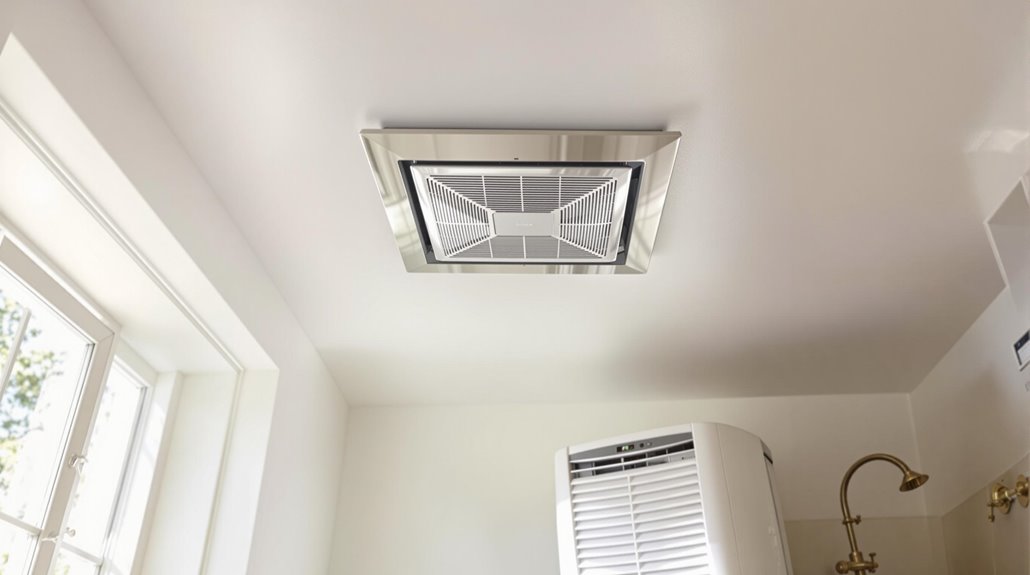
Proper ventilation and moisture control serve as the first line of defense against bathroom ceiling mold. Effective ventilation optimization requires installing an appropriately sized exhaust fan with proper ductwork that vents directly outdoors.
For maximum moisture management, the fan should operate during showers and continue running for at least 30 minutes afterward.
- Install an exhaust fan with a CFM rating matched to bathroom size
- Verify ductwork terminates outside with sealed vent hoods
- Incorporate timer or humidity controls for automated operation
- Maintain fan cleanliness with bi-annual maintenance
Beyond mechanical ventilation, natural airflow through open windows can supplement moisture reduction. Installing a dehumidifier provides additional protection in poorly ventilated spaces. Regular cleaning of surfaces and prompt repair of plumbing leaks further prevent moisture accumulation.
For enhanced effectiveness, consider upgrading to a humidity-controlled fan system that activates automatically when moisture levels exceed predetermined thresholds, verifying consistent atmospheric regulation in the bathroom environment.
Signs You Need Professional Help

While regular maintenance and ventilation can address minor mold issues, certain indicators signal the need for professional intervention. When bathroom ceiling mold displays extensive discoloration covering large areas or shows signs of penetrating the surface materials, professional remediation becomes necessary. The presence of dangerous spores, particularly black mold, requires immediate expert attention due to associated health risks.
| Warning Signs | Health Indicators | Safety Concerns |
|---|---|---|
| Large spread areas | Breathing difficulties | Complex removal needs |
| Deep penetration | Persistent allergies | Lack of proper equipment |
| Black mold presence | Unexplained illness | Hidden growth areas |
| Behind-wall growth | Constant musty odors | Structural damage risks |
| Multiple locations | Severe reactions | Limited DIY effectiveness |
Professional remediation services offer complete solutions, including specialized equipment, proper containment methods, and thorough inspection processes. Certified experts can identify hidden sources of moisture, assess structural damage, and implement effective long-term solutions while ensuring safe removal of contaminated materials.
Long-Term Prevention Strategies
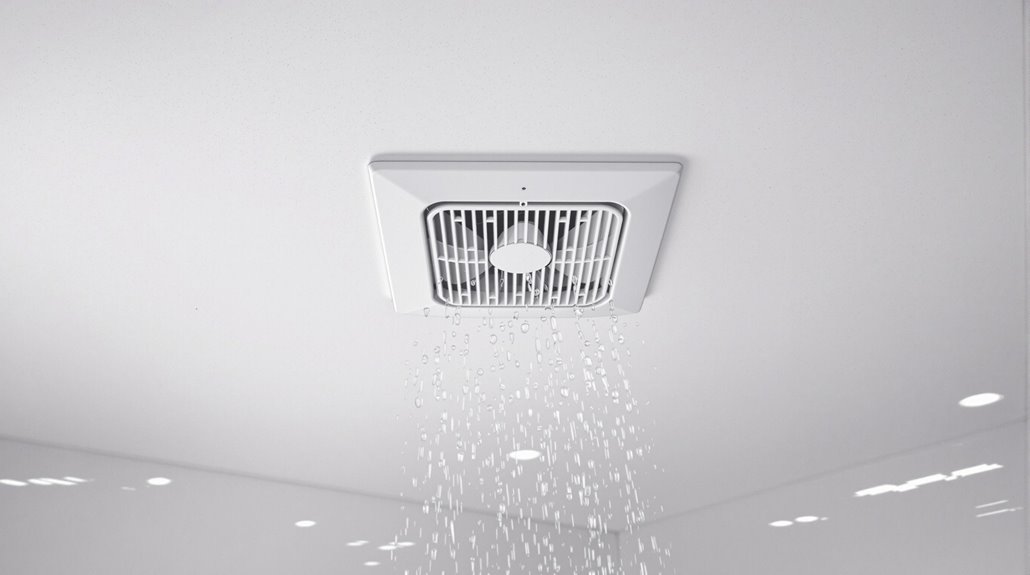
Preventing bathroom ceiling mold requires a systematic approach focused on moisture control and ventilation.
Installing proper ventilation systems with humidity-sensing controls, combined with daily practices like running exhaust fans and wiping down surfaces, creates an environment inhospitable to mold growth.
Applying moisture-resistant sealants and materials to bathroom surfaces, particularly ceilings, provides an additional barrier against mold formation while supporting other preventive measures.
Improve Air Circulation Daily
Effective air circulation serves as a fundamental defense against bathroom ceiling mold.
By implementing strategic ventilation practices, homeowners can substantially reduce moisture accumulation and prevent mold growth.
Proper daily sweeping of air through the bathroom, combined with precise window timing, creates an environment inhospitable to mold spores.
- Operate exhaust fans for 15-20 minutes after each shower, ensuring proper CFM ratings for the space
- Create cross-ventilation by opening windows and doors on opposite sides of the home
- Utilize HVAC system's "fan only" mode to enhance overall airflow
- Install humidity-sensing fans for automated moisture control
Regular implementation of these circulation strategies, combined with proper cleaning and maintenance, establishes a thorough approach to mold prevention.
Special attention should be paid to maintaining clean ventilation systems and ensuring proper installation of exhaust equipment.
Install Moisture-Control Systems
A thorough moisture-control system forms the backbone of long-term mold prevention in bathroom ceilings. Effective humidity monitoring through strategically placed dehumidifiers helps maintain ideal moisture levels, while proper airflow management using bathroom fans and ventilation systems prevents condensation buildup. These systems work together to create an environment inhospitable to mold growth.
Professional installation of moisture-control equipment guarantees ideal performance and includes specialized treatments such as borate-based solutions and mold-resistant primers.
The integration of waterproofing techniques, including appropriate moisture barriers and sealed vertical walls, further enhances the system's effectiveness. Regular maintenance of these controls, combined with continuous monitoring of humidity levels, creates a complete approach to preventing ceiling mold growth and protecting the bathroom's structural integrity.
Seal Surfaces Against Mold
To complement moisture-control systems, proper sealing of bathroom surfaces provides a strong defense against mold growth.
Creating effective waterproof membranes and silicone barriers requires specific materials and precise application techniques. Professional-grade bathroom sealants, particularly 100% silicone products with integrated fungicides, establish reliable protection against moisture infiltration.
- Apply mold-resistant caulk around fixtures, tubs, and sinks using proper sealing techniques
- Install waterproof grout between tiles, ensuring thorough coverage and proper curing
- Use bathroom-specific paint with anti-mold formulas on ceilings and walls
- Maintain silicone barriers through regular inspection and timely replacement
Regular maintenance of these protective barriers is essential for long-term mold prevention. Inspect seals quarterly for signs of wear, cracking, or discoloration, and address any compromised areas immediately using appropriate mold-resistant materials.
Maintenance Tips for Mold-Free Ceilings
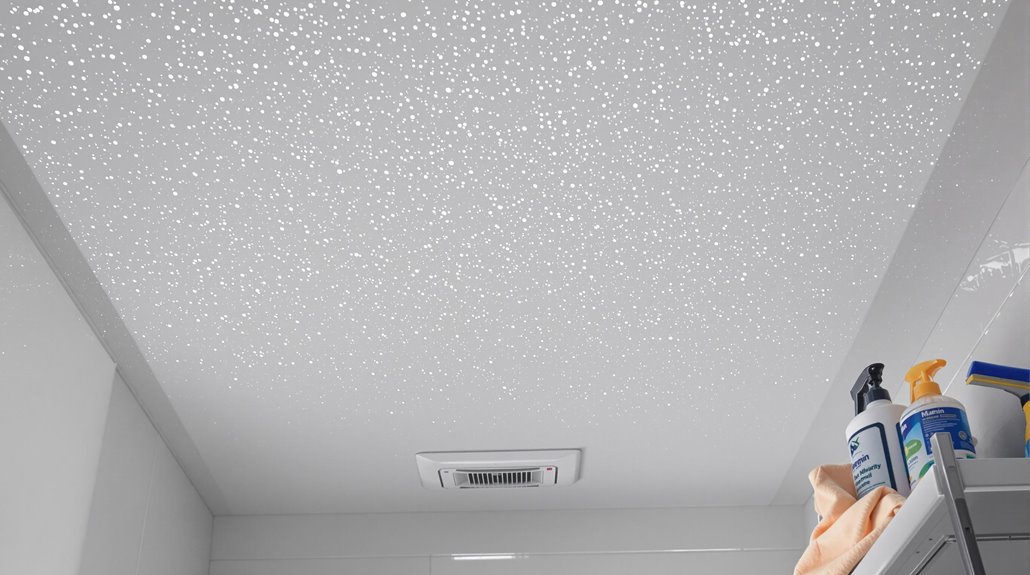
Maintaining a mold-free bathroom ceiling requires a thorough approach that combines proper ventilation, humidity control, regular cleaning, and surface protection.
Essential maintenance practices include operating exhaust fans during showers and for 20-30 minutes afterward to manage moisture levels.
Scheduled inspections of the ceiling should focus on identifying early signs of water damage or mold growth. Regular monitoring of humidity levels with a hygrometer helps guarantee conditions remain below 60%, while dehumidifiers can provide additional moisture control when needed.
Surface maintenance involves weekly cleaning with mild soap solutions and disinfectants to eliminate potential mold spores. After each shower, using a squeegee on walls and surfaces helps minimize moisture accumulation.
The integrity of waterproof barriers must be preserved through routine examination of seals, grout lines, and caulking around fixtures. When damage is detected, prompt repairs and touch-ups with mold-resistant materials prevent moisture penetration and subsequent mold growth.
The Benefits Of Consulting A Public Adjuster
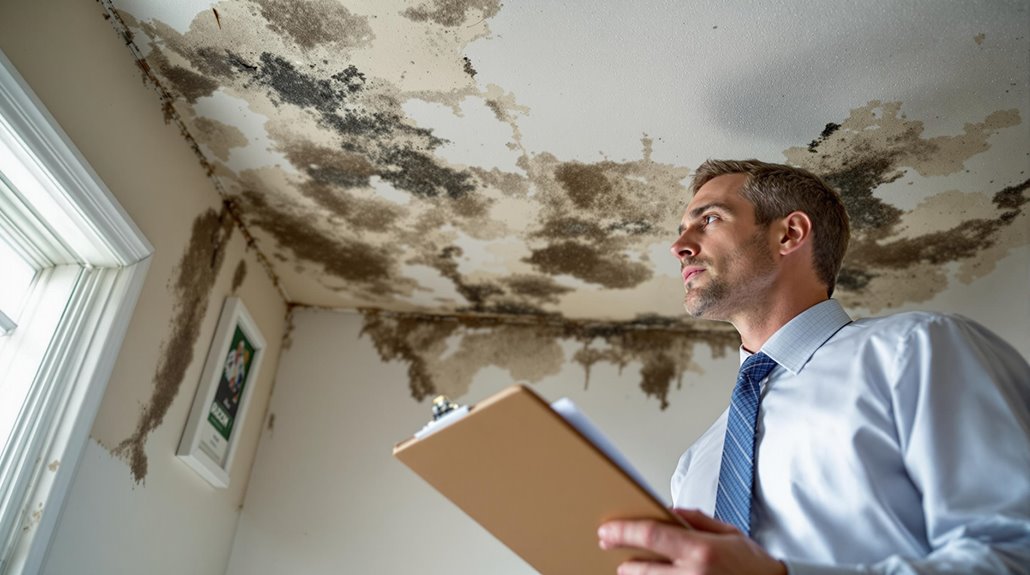
When dealing with extensive mold damage on bathroom ceilings, consulting a public adjuster provides critical expertise in managing insurance claims and securing appropriate coverage for remediation costs.
Public adjusters conduct thorough, objective assessments of mold-related damage, often identifying hidden issues that could affect long-term structural integrity and air quality.
Their specialized knowledge typically results in higher claim settlements and a more efficient claims process, ensuring homeowners receive adequate compensation for proper mold removal and prevention measures.
Expertise In Insurance Claims
Public adjusters bring invaluable expertise to insurance claims involving bathroom ceiling mold, offering professional guidance through complex policy interpretations and claim procedures.
Their thorough understanding of insurance navigation and claims management guarantees homeowners receive fair compensation for mold-related damages and necessary reme
Objective Damage Assessment
Professional damage assessment stands as a cornerstone benefit when consulting a public adjuster for bathroom ceiling mold issues. Through extensive visual inspection protocols and scientific measurement techniques, public adjusters conduct thorough evaluations to document the full extent of mold contamination.
These professionals utilize specialized equipment to detect hidden moisture pockets and mold growth within ceiling cavities and adjacent structures.
Their systematic approach includes detailed photographic documentation, moisture readings, and precise mapping of affected areas. By implementing standardized assessment procedures, public adjusters create extensive reports that accurately reflect the scope of damage and necessary remediation efforts. This objective documentation proves invaluable when dealing with insurance companies, ensuring that all damage-related costs are properly identified and included in the claim settlement process.
Streamlined Claim Process
Through strategic coordination with insurance providers, a streamlined claim process represents one of the most significant advantages of enlisting a public adjuster for bathroom ceiling mold issues. Public adjusters implement claims automation and settlement workflows to expedite the process while ensuring thorough documentation of mold damage.
Their expertise minimizes potential delays and maximizes settlement outcomes through efficient management of paperwork and communications.
- Documentation management and submission of required evidence
- Professional representation during insurance provider negotiations
- Technical assessment of mold-related damages and associated costs
- Strategic coordination of claim timelines and deadlines
Public adjusters leverage their understanding of policy nuances to optimize claim outcomes while reducing the policyholder's workload. This professional approach allows homeowners to focus on addressing immediate mold concerns while ensuring their insurance claim receives proper attention and fair evaluation.
Higher Claim Payouts & Settlements
Statistical evidence consistently demonstrates that engaging a public adjuster for bathroom ceiling mold claims results in substantially higher settlement amounts – often up to seven times more than self-managed claims.
This significant increase in claim payouts stems from public adjusters' thorough policy understanding and settlement expertise. Their ability to interpret complex insurance documentation enables them to identify overlooked coverage details and accurately assess the full scope of mold damage.
Operating on a contingency basis, these professionals leverage their negotiation skills to counter insurance company disputes effectively.
Professional adjusters collaborate with mold remediation specialists to document both visible and concealed damage, ensuring all necessary repairs and remediation costs are included in the settlement. Their technical knowledge and systematic approach maximize compensation while minimizing claim processing delays and potential coverage disputes.
About The Public Claims Adjusters Network (PCAN)
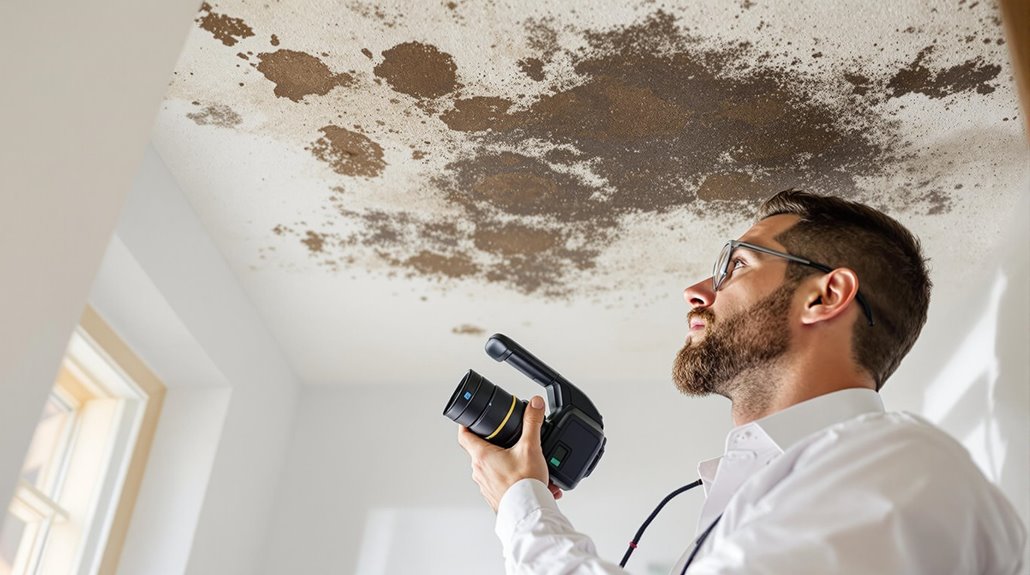
The Public Claims Adjusters Network (PCAN) serves as an independent advocate for policyholders dealing with property damage claims, including mold-related issues on bathroom ceilings. With their network capabilities extending across all 50 states and international locations, PCAN employs licensed professionals who specialize in thorough damage assessments and accurate claim valuations.
Their adjustment specialties encompass both residential and commercial properties, guaranteeing exhaustive coverage for various property types.
- Conducts detailed property damage evaluations to determine precise insurance compensation
- Manages documentation and submission processes for efficient claim processing
- Analyzes insurance policies to identify coverage limits and entitlements
- Oversees repair and reconstruction phases to guarantee proper implementation
PCAN's expertise extends beyond basic claims management, offering strategic support throughout the entire claims cycle.
Their professionals maintain strict adherence to legal and regulatory standards while facilitating clear communication between policyholders and insurance companies, ultimately maximizing claim settlements through expert negotiations and thorough documentation.
Frequently Asked Questions
Can Ceiling Mold Affect the Structural Integrity of My Roof?
Ceiling mold can cause significant structural deterioration of roofing components, leading to support weakening in wooden beams and other materials, potentially compromising the building's overall structural integrity and safety.
How Long Should I Wait Before Painting Over a Previously Moldy Ceiling?
Time is of the essence when drying treated ceiling surfaces. Professionals recommend waiting 24-48 hours post-cleaning, ensuring complete dryness before applying mold-resistant primer and appropriate paint selection.
Does Ceiling Mold Spread to Personal Belongings Stored in the Bathroom?
Mold spores can actively spread to items in bathroom storage, causing clothing contamination and damage to personal belongings. Proper ventilation and moisture control are essential to prevent cross-contamination of stored items.
Will My Home Insurance Cover Mold Removal From Bathroom Ceilings?
Like walking through a maze of fine print, bathroom ceiling mold coverage depends on its cause. Insurance typically excludes gradual moisture issues but may cover sudden incidents, subject to policy exclusions and coverage limitations.
Can Bathroom Ceiling Mold Cause Permanent Staining Even After Removal?
Mold can cause permanent discoloration patterns through deep pigment absorption into porous ceiling materials, leaving lasting stains even after proper removal and remediation of the fungal growth itself.
References
- https://www.theductkings.com/mold-removal-services/bathroom-ceiling/
- https://miamimoldspecialists.com/best-bathroom-tips-for-mold-prevention-2023/
- https://www.puroclean.com/matawan-nj-puroclean-of-matawan/blog/how-to-get-rid-of-mold-on-a-bathroom-ceiling/
- https://belloscleaning.com/how-to-clean-mold-off-the-bathroom-ceiling/
- https://www.christiansonco.com/removing-and-preventing-mold-mildew/
- https://www.taskrabbit.com/blog/how-to-remove-mold-from-bathroom-ceiling
- https://www.keystonestaterestoration.com/post/how-to-prevent-mold-in-the-bathroom-ceiling
- https://trusscore.com/blog/how-to-detect-and-prevent-mold-growth-on-your-bathroom-ceiling.html
- https://www.ultimatemoldcrew.ca/mold-on-ceiling/
- https://www.puroclean.com/moraine-oh-puroclean-emergency-services/blog/a-complete-guide-to-handling-bathroom-ceiling-mold/
